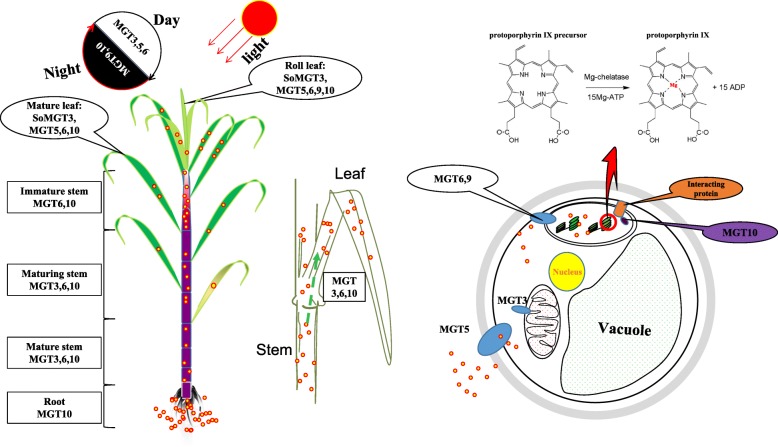Fig. 7.
Schematic model of MGT proteins based on gene expressions in sugarcane. MGT3 presented higher expression levels in leaves and mature stems (sink tissues) at the mature stage than that in the young tissues, in S.officinarum than in the S. spontaneum, and in leaf than in the stem. OsMGT1/OsMRS2–2 astheclosest orthologous genes of SoMGT3 specifically response to aluminum stress and salt stress at the root [58], indicating that SoMGT3 is likely to be involved in magnesium homeostasis in mature stems and leaf tissues during the light period in S. officinarum, but plays a limited role in S. spontaneum. Mg2+ is inserted into protoporphyrin IX via the magnesium-chelatase enzyme [2]. MGT6 was the most highly expressed gene among the gene families and displayed a constitutive expression pattern. It was induced by light with an expressional peak at noon. In pre-mature plants, MGT6 was highly expressed in the leaf and lowly expressed in roots. Magnesium concentrations of the chloroplast matrix in the light period were higher than in the dark period [90]. These results suggested that MTG6 is the dominant MGT for the maintenance of magnesium concentration in chloroplast during the light period in Saccharum. MGT5 and MGT9 had higher expression level in leaf than in the stems and root. In leaf, expressional level of MGT9 was gradient decrease from the base to the tip of leaf in the Saccharum, suggesting that MGT5 and MGT9 possibly played roles in leaf of sugarcane, and MGT9 probably functioned in the seeding stage of sugarcane. While MGT10 was abundant in the examined tissues and presented higher expression levels in root and mature stem than in other tissues, suggesting that MGT10 probably played a complementary role in magnesium transport in leave tissues in the light and dark period in S. spontaneum. It also may be responsible for the long-distance transport of magnesium from source (root) to sink (leaf)

